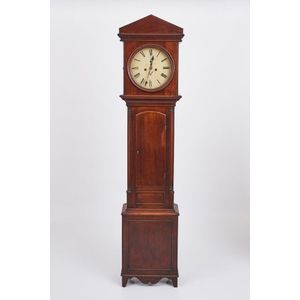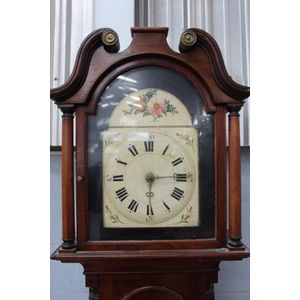
Rare 1830 Cedar Long-Cased Regulator Clock by R. Broad Sydney
A rare and fine long-case cedar long-cased regulator clock, by R Broad Sydney, circa 1830, 192 cm high, 42c cm wide 21 cm deep,

Rare Australian Cedar Long-Case Clock, 19th Century, Provenance Included
A rare cedar long-case clock, Australian 19th century. circular dial with brass two-train movement, . Provenance: The family of Cunningham McFarlane clockmakers of Melbourne circa 1853-1900. Sold Aingers Auctions, Melbourne 16/03/2008 lot 257 $$28,500),…

Honoring J. Crawford: Sterling Silver Plaque & Art Deco Clock
Presentation longcase clock with sterling silver plaque affixed: 'Presented to J. Crawford, Esq. By his Fellow members of the N.S.W. Lawn tennis ground in Honour of his 1933 Victories : Wimbledon : France : Australia : Davis Cup'. The clock is housed in…

Australian Arts & Crafts Blackwood Grandfather Clock
A stunning Australian Arts & Crafts grandfather clock, solid blackwood with carved gumnuts, leaves and oyster blackwood veneer dial and base, early 20th century, 191 cm high, 48 cm wide, 37 cm deep

1825 Australian Colonial Grandfather Clock
A rare Colonial long case grandfather clock, Australian cedar case, New South Wales origin, circa 1825, English twin weight movement, 228 cm high, 56 cm wide, 27 cm deep

Blackbutt Longcase Clock by James Howieson and Keininger
A West Australian longcase clock by James Howieson of Boyanup Gallery manufactured from Blackbutt and Blackbutt burl the mechanism by Keininger, from Stuttgart Germany 7 day movement, hourly gongs, quarter chimes height 218 cm

Black Forest Owl Carved Long Case Clock
A spectacular walnut carved Black Forest long case clock, c1900, the ornate case surmounted with a large three-dimensional owl, its wings outstretched, glass eyes, the entire case carved with fruiting grape vines, highlighted with two further smaller owls…

Colonial Kauri Long Case Clock with Cherub Mask Pediment
A good N.Z. colonial carved kauri long case clock, the pediment as a winged cherub mask above the 31 circular dial with cut brass applied Roman numerals and Art Nouveau copper hands, framed by a fruiting vine and scroll relief detail, above an open…

Hand-painted Colonial Cedar Longcase Clock with Wooden Movement
Colonial cedar longcase clock with swan neck scrolled pediment wooden hand painted face & wooden & brass movement

Late 19th Century Australian Long Case Clock
A cedar and fiddle back eucalypt long case clock, Australian, late 19th century, 211 cm high, 37 cm wide, 39 cm deep

Colonial Cedar Longcase Clock with Thomas Hope Pediment
Colonial cedar longcase clock with Thomas Hope scrolled pediment and bracket feet to base, inscription in pencil inside, - Emma sailed Sydney 14th December 1852

James Oatley Longcase Clock, No. 23, 1822
An important Australian cedar and casuarina longcase clock by James Oatley, circa 1822, No 23, by James Oatley, circa 1822, No 23 the hood with a swan neck pediment with three brass ball finials over a cedar and pine strung door, flanked by freestanding…

1820 James Oatley Colonial Australian Cedar Longcase Clock
A highly important early Colonial Australian cedar longcase clock by James Oatley, Sydney 1820, the dial inscribed 'Oatley Sydney 1820', the hood with a swan neck pediment over a circular casuarina veneered door, flanked by freestanding twisted reeded…
 Loading more...
Loading more...